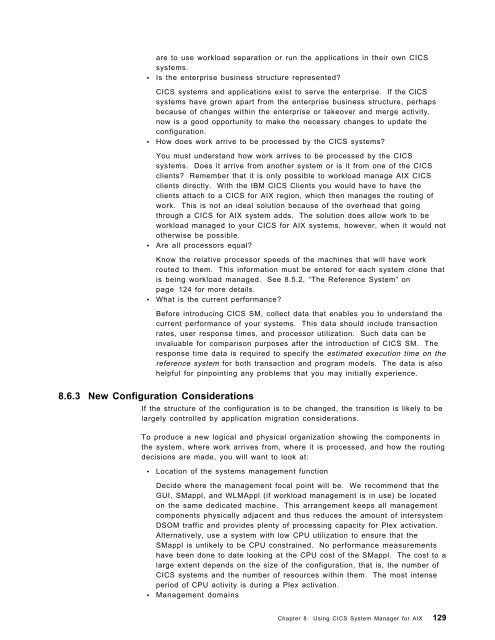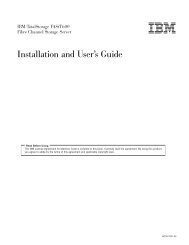Addressing OLTP Solutions with CICS: The Transaction Server ... - Ibm
Addressing OLTP Solutions with CICS: The Transaction Server ... - Ibm
Addressing OLTP Solutions with CICS: The Transaction Server ... - Ibm
Create successful ePaper yourself
Turn your PDF publications into a flip-book with our unique Google optimized e-Paper software.
are to use workload separation or run the applications in their own <strong>CICS</strong><br />
systems.<br />
• Is the enterprise business structure represented?<br />
<strong>CICS</strong> systems and applications exist to serve the enterprise. If the <strong>CICS</strong><br />
systems have grown apart from the enterprise business structure, perhaps<br />
because of changes <strong>with</strong>in the enterprise or takeover and merge activity,<br />
now is a good opportunity to make the necessary changes to update the<br />
configuration.<br />
• How does work arrive to be processed by the <strong>CICS</strong> systems?<br />
You must understand how work arrives to be processed by the <strong>CICS</strong><br />
systems. Does it arrive from another system or is it from one of the <strong>CICS</strong><br />
clients? Remember that it is only possible to workload manage AIX <strong>CICS</strong><br />
clients directly. With the IBM <strong>CICS</strong> Clients you would have to have the<br />
clients attach to a <strong>CICS</strong> for AIX region, which then manages the routing of<br />
work. This is not an ideal solution because of the overhead that going<br />
through a <strong>CICS</strong> for AIX system adds. <strong>The</strong> solution does allow work to be<br />
workload managed to your <strong>CICS</strong> for AIX systems, however, when it would not<br />
otherwise be possible.<br />
• Are all processors equal?<br />
Know the relative processor speeds of the machines that will have work<br />
routed to them. This information must be entered for each system clone that<br />
is being workload managed. See 8.5.2, “<strong>The</strong> Reference System” on<br />
page 124 for more details.<br />
• What is the current performance?<br />
Before introducing <strong>CICS</strong> SM, collect data that enables you to understand the<br />
current performance of your systems. This data should include transaction<br />
rates, user response times, and processor utilization. Such data can be<br />
invaluable for comparison purposes after the introduction of <strong>CICS</strong> SM. <strong>The</strong><br />
response time data is required to specify the estimated execution time on the<br />
reference system for both transaction and program models. <strong>The</strong> data is also<br />
helpful for pinpointing any problems that you may initially experience.<br />
8.6.3 New Configuration Considerations<br />
If the structure of the configuration is to be changed, the transition is likely to be<br />
largely controlled by application migration considerations.<br />
To produce a new logical and physical organization showing the components in<br />
the system, where work arrives from, where it is processed, and how the routing<br />
decisions are made, you will want to look at:<br />
• Location of the systems management function<br />
Decide where the management focal point will be. We recommend that the<br />
GUI, SMappl, and WLMAppl (if workload management is in use) be located<br />
on the same dedicated machine. This arrangement keeps all management<br />
components physically adjacent and thus reduces the amount of intersystem<br />
DSOM traffic and provides plenty of processing capacity for Plex activation.<br />
Alternatively, use a system <strong>with</strong> low CPU utilization to ensure that the<br />
SMappl is unlikely to be CPU constrained. No performance measurements<br />
have been done to date looking at the CPU cost of the SMappl. <strong>The</strong> cost to a<br />
large extent depends on the size of the configuration, that is, the number of<br />
<strong>CICS</strong> systems and the number of resources <strong>with</strong>in them. <strong>The</strong> most intense<br />
period of CPU activity is during a Plex activation.<br />
• Management domains<br />
Chapter 8. Using <strong>CICS</strong> System Manager for AIX 129
















